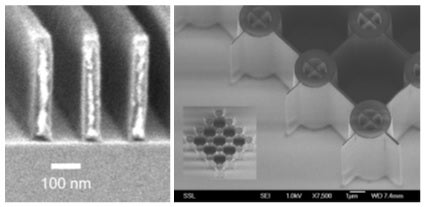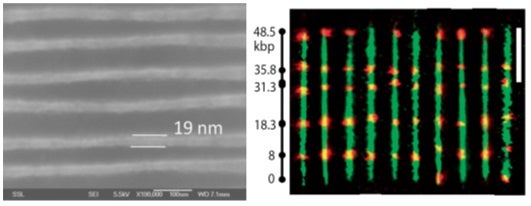3D nanofabrication with protons
Jeroen Anton VAN KAN (Group Leader, Physics) () September 23, 201423 Sep 2014. NUS physicists shared an overview of the growing number of resist materials for proton lithography down to 19 nm.
Proton Beam Writing is a new 3D nanolithographic technique capable of producing of well-defined high density nanostructures (see Figure 1). Typical applications can be found in nanofluidic lab on chip devices for single molecule studies as well as advanced applications in optics and photonics. This application compares many different resist materials for proton beam writing which can be used either directly, or can be used as a base to make molds and stamps. These molds and stamps can then be employed to amplify the output of this technique through nanoimprinting.
With the recent introduction of a new proton beam writing facility, a team led by Prof Jeroen Anton VAN KAN from the Department of Physics in NUS has managed to fabricate details down to 19 nm in width standing 100 nm tall (see Figure 2). These structures are actively used in nanofluidics studies e.g. large scale Genome sequencing.

Figure 1 (Left) SEM image of parallel lines written in a 350 nm thick PMMA layer. The structure was written with a focused 2 MeV proton beam. The photo indicates a wall width of 50 nm. Reproduced from [2]. (Right) High aspect ratio structure fabricated using PBW in SU-8 negative resist, showing 60 nm wall structures 10 µm deep, reproduced from [3].(Image credit: Appl. Phys. Lett. 83 & Int. J. Nanosci. 4)

Figure 2 (Left) SEM images of 19 nm line width with a spacing of 80 nm on 100 nm thick HSQ sample written by a focused 2 MeV proton beam, reproduced from [4]. (Right) Montage of fluorescence images of λ-DNA. The images obtained with YOYO-1 (green) and Alexa Fluor 541 (red) staining are superposed. The molecules are confined in 150_250nm2 channels. Labelling sites are noted. The scale bar denotes 5 µm reproduced from [5]. (Image credit: Microsyst. Technol & Nucleic Acids Res. 41)
References
- van Kan JA, Malar P, Wang YH. “Resist materials for proton beam writing: A review.” Applied Surface Science 310 (2014) 100.
- van Kan JA, Bettiol AA, Watt F. ”Three-dimensional nanolithography using proton beam writing.” Applied Physics Letters 83 (2003) 1629.
- Watt F, Bettiol AA, van Kan JA, Teo EJ, Breese MBH. “Ion beam lithography and nanofabrication: a review.” International Journal of Nanoscience 4 (3) (2005) 269.
- Yao Y, Raman PS., van Kan JA. “Orthogonal and fine lithographic structures attained from the next generation proton beam writing facility.” Microsystem Technologies (2014) http://dx.doi.org/10.1007/s00542-014-2066-2.
- Zhang C, Hernandez-Garcia A, Jiang K, Gong Z, Guttula D, Ng SY, Malar PP, van Kan JA, Liang D, Doyle PS, de Vries R, van der Maarel JRC. “Amplified stretch of bottlebrush-coated DNA in nanofluidic channels.” Nucleic Acids Research 41 (2013) e189.


